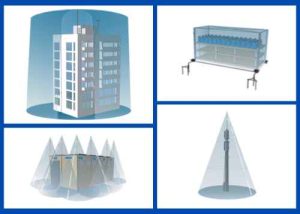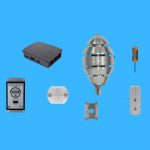The different direct impact capture systems
| The early streamer emitter lightning rod | The simple tip | The Faraday cage or meshed cage | The taut cables |
| Early Streamer Emitter (ESE) lightning rods feature technology that aims to capture lightning proactively. They create a preferential path for lightning by initiating an ascending tracer, which allows it to be captured more effectively and to protect a wider area than that covered by traditional lightning rods. | Franklin simple lightning rods, also called traditional lightning rods, are composed of a metal rod that rises above the structure to be protected. When a storm occurs, the rod passively attracts lightning providing a restricted area of protection. | A meshed cage, also known as a Faraday cage, consists of a structure made of electrical conductors arranged in the form of a mesh or grid topped with several franklin simple rod . This configuration allows electrical charges to be distributed around the cage, thus protecting everything inside against the effects of lightning. | Lightning protection using tensioned cables consists of installing horizontal metal cables stretched above the structure to be protected. These cables are connected to grounding systems, creating a network that intercepts lightning strikes and directs them to the ground. This method is often used to protect extensive infrastructure such as power lines, pipelines, or communications antennas. |
In the field of lightning protection, lightning rods are crucial devices for securing structures and preventing damage caused by electrical discharges. Traditionally, several methods have been used, such as simple-point lightning rods, meshed cages, and tensioned cables. However, these approaches can sometimes have limitations in terms of efficiency and reliability. This is where lightning rods come in, offering improved protection and significant advantages over traditional methods.
1. Increased sensitivity to lightning detection
Early Streamer Emitter lightning rods are designed to detect electric fields ahead of an imminent lightning strike. This capability allows them to initiate the grounding process even before the lightning directly strikes the protected structure. In comparison, other methods may lack this early sensitivity, potentially putting the structure at increased risk of damage.
2. Reduced risk of power surges
By initiating the dissipation of electrical energy before lightning strikes, early streamer emitter lightning rods help minimize the risk of surges in electrical installations. This proactive action can protect sensitive equipment from costly damage and associated downtime.
3. Effectiveness in various weather conditions
Early Streamer Emitter lightning rods are less susceptible to weather interference such as rain, snow or fog, compared to single tip lightning rods or meshed cages. Their ability to operate reliably in a wide range of weather conditions ensures continued protection, even in harsh environments.
4. Flexible and discreet installation
Unlike tensioned cables which may require visible and bulky installation, Early Streamer Emitter lightning rods offer a more discreet solution. Their compact design and flexible installation make them suitable for a variety of structures, including historic or architecturally sensitive buildings.
5. Proven reliability
Early Streamer Emitter lightning rods have a proven track record of providing lightning protection in a variety of environments and applications, from residential buildings (houses, apartment blocks) to complex industrial infrastructure (pylons, factories, etc.). Their growing adoption testifies to their effectiveness and reliability in securing property and lives against the dangers of lightning.
In conclusion, Early Streamer Emitter lightning rods represent a significant advancement in lightning protection technology, offering increased sensitivity, proven reliability and installation flexibility compared to traditional methods such as single tip lightning rods, meshed cages and taut cables. Their use helps maximize the safety of structures and equipment, providing peace of mind in the face of the vagaries of the weather.





